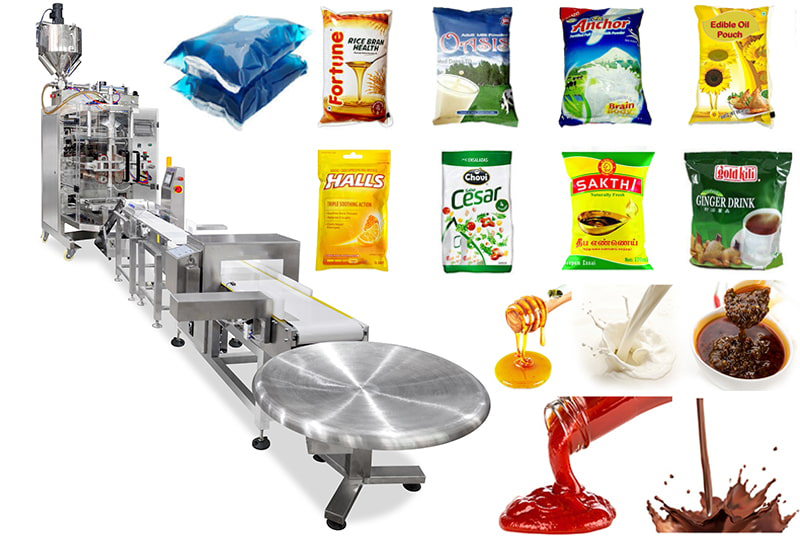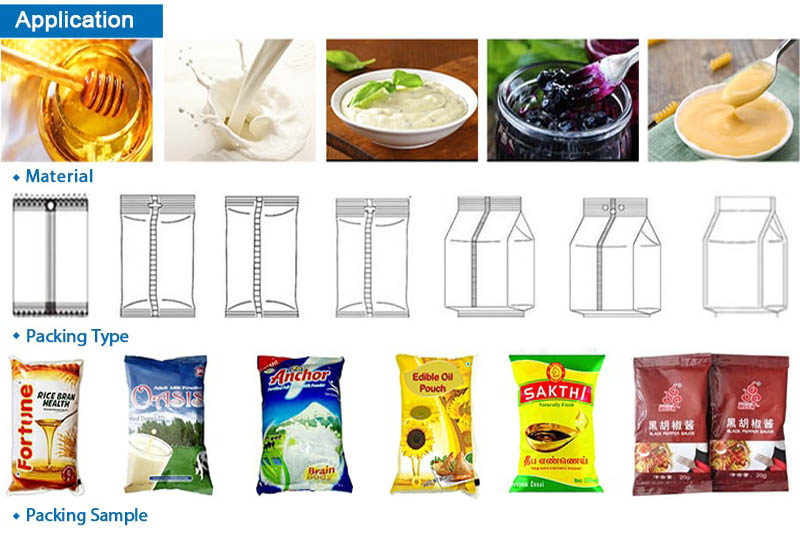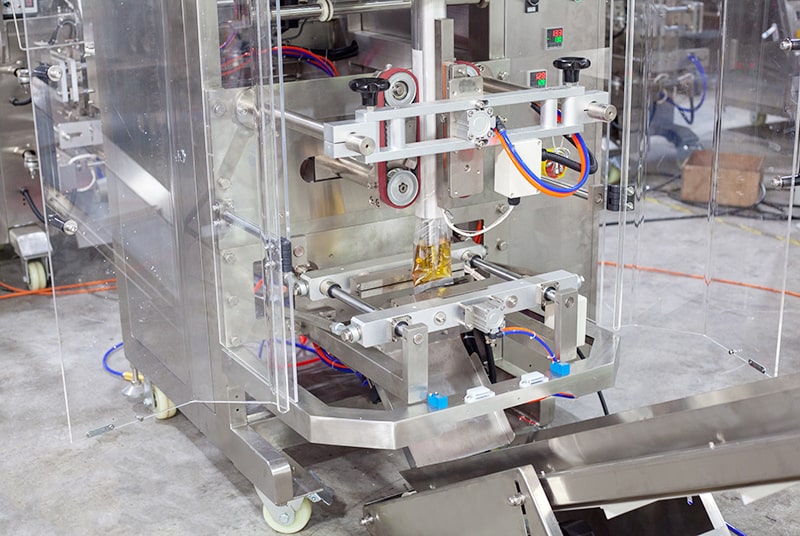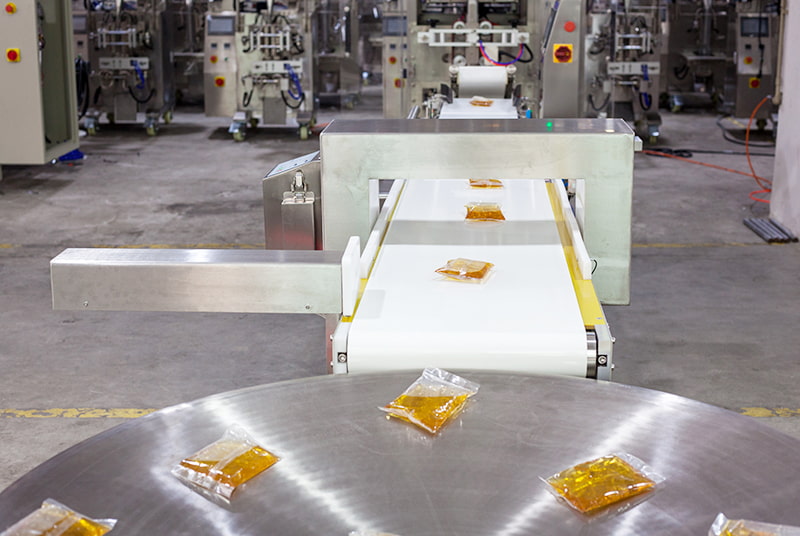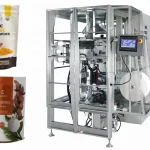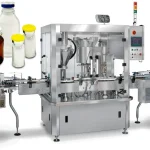Automatic Liquid Packing System With Weight Detector And Metal Detector
Description
Application:
Automatic liquid packing system with weight detector and metal detector is suitable for a variety of high-value liquid products, such as Honey, sauces, oils and various chemical and industrial liquids.
Kindly Reminder:
We have experienced team of R & D engineers who can customize packaging solutions according to your product characteristics.
Packing Exambers:
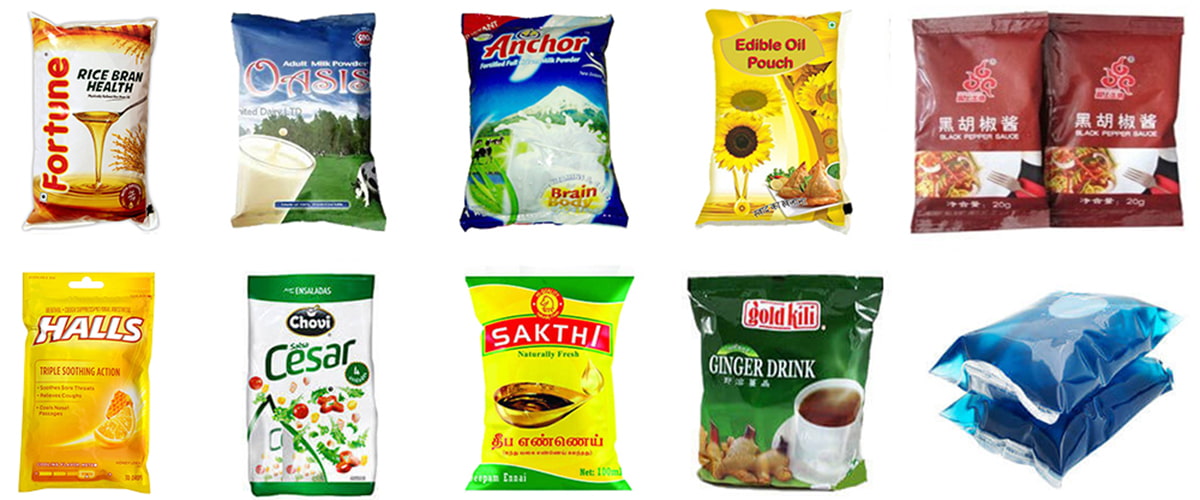
Products dosing, Filling, Laminate heat sealable pouch making and sealing.
Stainless steel 304 structure and surface.
Weighing and Packaging PLC & HMI Control Integrated, More stable operation, Easy for parameter setting.
Simple changing of pouch former, to adapt different pouch size requirement.
Intelligent temperature controlling configuration, ensure the artistic and neat sealing.
Configure with packaging film pre-pulling device, to enable stable pouch making.
No film no filling, and easy to change the packaging film.
Parameter
| Model | VK-420L | VK-520L |
| Film Width | Max.420mm | Max.520mm |
| Bag Length | 80-300mm | 80-350mm |
| Bag Width | 60-200mm | 100-250mm |
| Range of Measurement | 150-1500ml | 2000ml |
| Film Roll Diameter | Max.320mm | Max.320mm |
| Packaging Rate | 10-60bag/min | 10-60bag/min |
| Power | 220V 50/60Hz 2KW | 220V 50/60Hz 3KW |
| Machine Size(L*W*H) | 1217*1015*1343mm | 1488*1080*1490mm |
| Machine Quality | About 650kg | About 680kg |
| Optional device | 1. Date Printing, 2. Hole Punching Device, 3. Air-filling Device, 4. Tear Notch Device | |
Automating liquid packaging with weight and metal detection is a process that can significantly improve the efficiency of liquid packaging operations. This process utilizes advanced technology to accurately measure the weight of liquids and detect any foreign objects, such as metal particles, in the product. Automation of this process helps to reduce labor costs and improve product quality by ensuring that all packages meet industry standards. Additionally, automated liquid packaging with weight and metal detection can help increase production speeds while reducing waste due to incorrect measurements or contamination. By automating this process, businesses can benefit from improved efficiency and cost savings while providing customers with safe and reliable products.
Automating Liquid Packaging with Weight and Metal Detection: Benefits and Challenges
Automating liquid packaging with weight and metal detection offers numerous benefits to the food and beverage industry. This process can help increase efficiency, reduce costs, and improve product safety. Automation can also help reduce waste, as well as provide a more consistent product quality.
The primary benefit of automating liquid packaging with weight and metal detection is that it eliminates the need for manual inspection of each package. This reduces labor costs and increases productivity. Additionally, automated systems are more accurate than manual inspections, resulting in fewer mistakes or errors in the packaging process. Automation also helps ensure that all packages meet regulatory standards for food safety by detecting any foreign objects or contaminants before they enter the package.
Another benefit of automating liquid packaging with weight and metal detection is that it reduces waste by eliminating over-filling or under-filling of packages due to inaccurate measurements taken during manual inspections. Automated systems can also detect leaks in packages which would otherwise go undetected during manual inspections. Finally, automated systems provide a more consistent product quality by ensuring that all packages are filled to exact specifications every time they are produced.
Despite these benefits, there are some challenges associated with automating liquid packaging with weight and metal detection processes as well. These include high initial capital costs associated with purchasing equipment; potential delays due to installation times; technical difficulties related to software updates; and training staff on how to use new technology properly and safely. Additionally, there may be additional costs associated with maintenance of automated systems over time which should be taken into consideration when making decisions about automation investments in this area
Integrating Advanced Technologies for Automated Liquid Packaging with Weight and Metal Detection
Integrating advanced technologies for automated liquid packaging with weight and metal detection is a process that combines the latest in automation and sensing technology to ensure the safety of packaged liquids. This process uses sensors to detect any foreign objects or materials, such as metal, that may be present in the liquid. It also uses weight sensors to measure the amount of liquid being packaged, ensuring accuracy and consistency. The integration of these technologies helps streamline production processes while ensuring product safety and quality control.
Quality Assurance in Automated Liquid Packaging with Weight and Metal Detection
Quality Assurance in Automated Liquid Packaging with Weight and Metal Detection is a comprehensive system that ensures the safety and accuracy of liquid packaging processes. This system combines advanced weight detection technology with metal detection capabilities to detect potential contaminants, such as metal fragments, before they enter the product stream. The weight detection technology is used to ensure that each package contains the correct amount of liquid while the metal detection capability provides an additional layer of protection against contamination. This system also includes automated quality assurance checks to verify product integrity throughout the packaging process. By utilizing this comprehensive approach, companies can be confident that their products are safe and free from contamination before they reach consumers.
Optimizing Performance of Automated Liquid Packaging with Weight and Metal Detection
Optimizing the performance of automated liquid packaging with weight and metal detection is a critical process for ensuring product safety and quality. Weight and metal detection systems are used to detect any foreign objects or contaminants in the liquid packaging, such as glass shards, metal fragments, or plastic pieces. These systems also measure the weight of each package to ensure that it meets predetermined specifications. By optimizing these systems, manufacturers can ensure that their products meet safety standards while minimizing costs associated with recalls or customer complaints. The optimization process typically involves calibrating the system’s sensors to accurately detect foreign objects and contaminants, adjusting settings to improve accuracy and speed of detection, and testing various packages for accuracy. With optimized performance, automated liquid packaging with weight and metal detection can provide a reliable way to protect consumers from potential hazards while ensuring product quality.
Troubleshooting Common Issues in Automated Liquid Packaging with Weight and Metal Detection
Troubleshooting common issues in automated liquid packaging with weight and metal detection is a critical part of the production process. This process involves detecting and correcting any problems that may arise in the production line, such as incorrect weight or metal detection readings. To ensure accurate results, it is important to check for any errors in the equipment setup, calibration, or operation. Additionally, regular maintenance should be performed to identify any potential problems before they become an issue. Troubleshooting also includes checking for mechanical issues with the machinery itself and ensuring that all components are functioning properly. By following these steps, automated liquid packaging lines can be kept running smoothly and efficiently.
Conclusion
Automating liquid packaging with weight and metal detection is a cost-effective and efficient way to improve the safety of packaged liquids. It eliminates the need for manual inspection, reduces human error, and increases production speeds. Additionally, it can help ensure that products meet quality standards while reducing waste. This technology can be used in any size packaging operation to improve product safety and increase efficiency.


